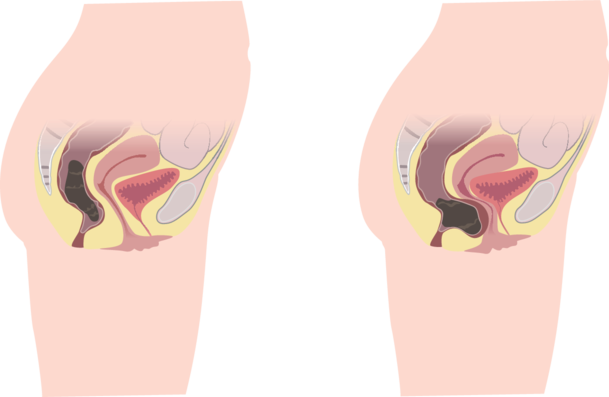A rectocele is a bulge in the anterior or posterior rectal wall, that traps stool resulting in incomplete emptying.
Symptoms of rectocele
Rectocele or posterior vaginal prolapse is a common condition in women, where the rectum pushes forward into the posterior wall of the vagina, causing a lump inside the vagina. Stool is trapped there, thus making it hard to empty the bowel completely and also the bladder i.e., to void urine. Problems with the bladder can coexist with a rectocele either as urinary retention by blockage of the urethra or as urinary incontinence if the rectocele is along a cystocele or bladder prolapse. Other symptoms of rectocele include fecal incontinence, need for self-digitation, pelvic or rectal pain and sexual dysfunction.

Cause of rectocele
The incidence of rectocele is not known, numbers vary in different studies from 20-80% depending on population, for example a study showed that 40% of women having had multiple births had asymptomatic rectoceles. A rectocele is caused by prolonged pressure on the pelvic floor and risk factors includes pregnancy and vaginal delivery, obesity, chronic constipation and advanced age. Chronic cough or bronchitis can also cause pressure on the pelvic floor area and increase the risk of a rectocele.
The symptoms of a rectocele impacts quality of life and a rectocele can increase the risk of rectal prolapse.
Rectal prolapse and enterocele
Rectal prolapse is similar to, but not the same as, a rectocele. A prolapse of rectum evolves from excessive straining over time that leads to weakness of pelvic floor muscles and connective tissue injury including nerve injury and neuropathy. This in turn results in loss of counter-acting resistive force during defecation. Rectal prolapse, also called rectal procidentia, can be divided into different stages of progression. At an early stage, the rectum becomes poorly attached but stays within the body most of the time. This stage is called mucosal prolapse, or partial prolapse, meaning that only the inner lining of the rectum (rectal mucosa) protrudes from the anus. In the later stage, when the rectum becomes more prolapsed, the ligaments and muscles may weaken to the point that a large portion of the rectum protrudes from the body through the anus. This stage is called complete prolapse, or full-thickness rectal prolapse, and is the most commonly recognized stage of the condition. Initially, the rectum may protrude and retract depending on the person's movements and activities. However, if the condition goes untreated, the rectum may protrude more frequently or even permanently.
There are several risk factors and different causes of rectal prolapse which include long-term constipation or diarrhea, childbirth, large hemorrhoids, as well as pelvic floor anatomic defects such as rectocele, cystocele and enterocele.
An enterocele is when the intestines (small bowel) protrude through defective or weak tissue causing symptoms of repeated urge, i.e. ”gotta go, gotta go again”. There are four types of enterocele based on the cause of the bulge that could be due to either continual pressure (chronic cough/extreme exercise), pregnancy/childbirth/estrogen loss, earlier repair procedures in the pelvic floor, or birth defects.
Treatment of rectocele
Rectocele is a structural problem for which most often symptoms may be treated with non-surgical options such as medical management, lifestyle alteration, pelvic floor re-training or transanal irrigation. Transanal irrigation may reduce the symptoms of rectocele by using a low volume (<250 ml) of water to assist a complete emptying of the rectum.